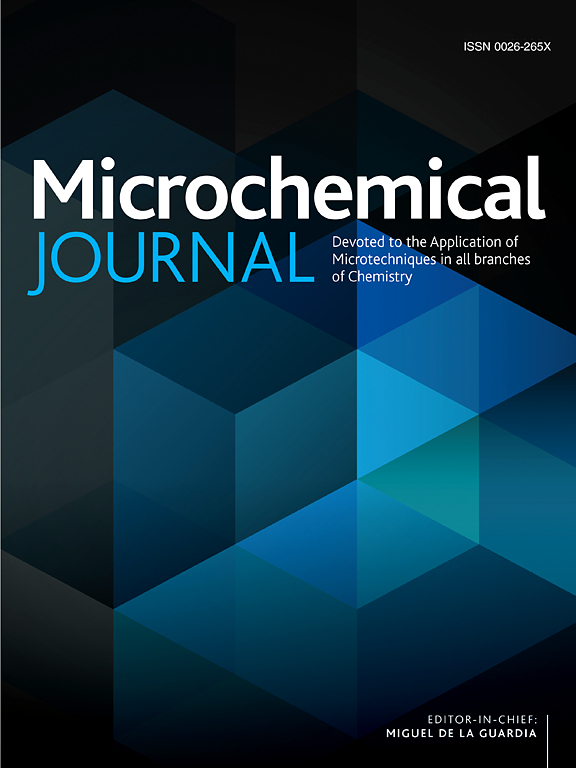单花和多花蜂蜜中酚类物质的LC-MS/MS定量:MoGAPI和MoGSA评价方法的绿色度
IF 4.9
2区 化学
Q1 CHEMISTRY, ANALYTICAL
引用次数: 0
摘要
本研究对云南产单花和多花蜂蜜的理化性质、总酚含量(TPC)、总黄酮含量(TFC)、抗氧化活性、原花青素含量和多酚类成分进行了研究。此外,使用MoGSA和MoGAPI两种不同的评价工具对分析方法的绿色度进行了评估。多花蜜的TPC和TFC值分别为0.18 ~ 0.65 mg GAE/g和0.01 ~ 0.09 mg QE/g,而单花蜜的TPC和TFC值分别为0.16 ~ 0.98 mg GAE/g和0.01 ~ 0.37 mg QE/g。Erica蜂蜜中CUPRAC和DPPH值最高,与TFC和总个体多酚化合物的结果一致。值得注意的是,与其他样品相比,Erica spp.蜂蜜样品显示出更高的没食子酸含量(26.13µg/g)。这些发现表明,埃里卡蜂蜜具有高TPC、抗氧化活性和独特的多酚特征,可能是抗氧化剂的重要膳食来源。此外,该方法的MoGAPI和MoGSA得分分别为84和91.67,表明其具有较高的环境可持续性。本文章由计算机程序翻译,如有差异,请以英文原文为准。
Quantification of phenolics by LC-MS/MS of monofloral and polyfloral Honey: Evaluation of the greenness of the method with MoGAPI and MoGSA
This study evaluated the physicochemical properties, total phenolic content (TPC), total flavonoid content (TFC), antioxidant activity, proanthocyanidin content, and polyphenolic profiles of monofloral and multifloral honey samples produced in Türkiye. In addition, the greenness of the analytical method was assessed using two different evaluation tools: MoGSA and MoGAPI. The TPC and TFC values for multifloral honeys ranged from 0.18–0.65 mg GAE/g and 0.01–0.09 mg QE/g, respectively, whereas for monofloral honeys, these values ranged from 0.16–0.98 mg GAE/g and 0.01–0.37 mg QE/g. The highest CUPRAC and DPPH values were observed in Erica spp. honey, consistent with its TFC and total individual polyphenolic compound results. Notably, the Erica spp. honey sample exhibited a significantly higher gallic acid content (26.13 µg/g) compared to the other samples. These findings suggest that Erica spp. honey characterized by its high TPC, antioxidant activity, and distinctive polyphenolic profile, may serve as a notable dietary source of antioxidants. Additionally, the MoGAPI and MoGSA scores of the method were determined to be 84 and 91.67, respectively, demonstrating its high environmental sustainability.
求助全文
通过发布文献求助,成功后即可免费获取论文全文。
去求助
来源期刊

Microchemical Journal
化学-分析化学
CiteScore
8.70
自引率
8.30%
发文量
1131
审稿时长
1.9 months
期刊介绍:
The Microchemical Journal is a peer reviewed journal devoted to all aspects and phases of analytical chemistry and chemical analysis. The Microchemical Journal publishes articles which are at the forefront of modern analytical chemistry and cover innovations in the techniques to the finest possible limits. This includes fundamental aspects, instrumentation, new developments, innovative and novel methods and applications including environmental and clinical field.
Traditional classical analytical methods such as spectrophotometry and titrimetry as well as established instrumentation methods such as flame and graphite furnace atomic absorption spectrometry, gas chromatography, and modified glassy or carbon electrode electrochemical methods will be considered, provided they show significant improvements and novelty compared to the established methods.
 求助内容:
求助内容: 应助结果提醒方式:
应助结果提醒方式:


